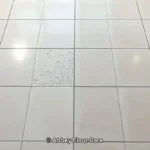Summary of “Mastering the Art of Cleaning and Sealing Slate Floors”:
- Understanding the Importance of Cleaning and Sealing Slate: This text discusses the necessity of both cleaning and sealing to preserve the natural beauty and longevity of slate surfaces.
- Essential Tools for Slate Maintenance: Must-have tools include pH-neutral cleaners, microfiber mops, soft-bristled brushes, and top-quality sealers.
- Step-by-Step Guide to Cleaning Slate Floors: Provides a comprehensive guide on dusting, mopping, and effectively removing stubborn stains using gentle methods.
- Drying and Inspecting Your Slate Floors: Highlights the importance of allowing floors to dry completely before checking for any embedded stains or damage.
- The Comprehensive Sealing Process: Explains how to choose the appropriate type of sealer (penetrating versus topical) and apply it evenly for optimal results.
- Essential Aftercare for Slate Floors: Offers tips for maintaining a clean slate surface post-sealing, including spot-cleaning and routine upkeep.
- Avoiding Common Slate Maintenance Mistakes: Cautions against using acidic cleaners, excess moisture, and improper application of sealers.
- The Advantages of Professional Slate Cleaning Services: It is suggested to contact expert stone cleaners for heavily soiled or previously unsealed slate floors.
Exploring the Diverse World of Slate in the United Kingdom
Discover the Varieties of Slate Found Across the UK

Clean and Seal Slate Floors Professionally with These Tips: Slate is a remarkable metamorphic rock that has significantly influenced the architectural landscape of the United Kingdom for centuries. Its unique physical properties make it an exceptional material for various applications in both residential and commercial buildings throughout the region. In the UK, a range of slate types are prevalent, each possessing distinctive characteristics. For instance, Welsh slate is highly regarded for its vibrant hues and remarkable durability, making it a preferred choice for roofing, flooring, and garden landscaping projects. This type of slate is synonymous with high quality, particularly those sourced from quarries in Patagonia, known for their rich colours and exceptional strength.
Another well-known variety is Cornish slate, known for its darker shades and frequent use in luxury and traditional architectural designs. Its historical significance has contributed to its enduring popularity, especially in projects focused on heritage conservation. Finally, Lake District slate is celebrated for its varied colours and textures, often seen in rustic settings that beautifully complement the surrounding natural scenery. The diverse types of slate not only enhance visual appeal but also provide practical benefits, as their durability is well-suited to withstand the UK’s notoriously unpredictable weather patterns.
Uncovering the Versatile Applications of Slate in UK Architecture
The remarkable versatility of slate is evident in its extensive applications across UK architecture. Historically, slate has been a preferred material for roofing due to its superior resistance to environmental elements and its elegant aesthetic. Numerous historical structures in the UK, such as the iconic slate roofs found in the Welsh countryside, exemplify the longevity and resilience of this material. Beyond roofing, slate is increasingly embraced for use in flooring and cladding, adding a touch of natural beauty and timeless elegance to interior spaces.
Moreover, slate has established its presence in public buildings and civic environments. The Town Hall in Manchester, featuring a striking slate façade, illustrates how this material can create impressive and enduring public architecture. Even in modern designs, architects are drawn to slate for its sustainable qualities and low maintenance requirements. These applications underscore slate’s adaptability, solidifying its status as a fundamental material in both traditional and contemporary construction projects.
Understanding the Importance of Slate Maintenance in the UK’s Unique Climate
The UK’s distinct climate presents unique challenges for slate, making regular maintenance crucial for preserving its aesthetic appeal and functionality. The combination of consistent rainfall, high humidity levels, and fluctuating temperatures can lead to the growth of moss and algae, which, if not addressed promptly, can result in staining and deterioration of the slate’s surface. Therefore, homeowners and property managers must understand the appropriate care techniques for slate to ensure its longevity.
Implementing scheduled inspections and routine cleanings can significantly prolong the lifespan of slate installations. This proactive approach not only enhances the slate’s visual appeal but also prevents more costly repairs in the future. Additionally, applying a high-quality slate cleaner and sealer at regular intervals can protect the surface from moisture-related damage and environmental factors, allowing the slate to maintain its vibrant colours and structural integrity amidst the challenges posed by the UK’s weather conditions.
Selecting the Most Effective Slate Cleaner for Your Needs

Understanding the Unique Cleaning Challenges Faced in the UK
Cleaning slate in the UK necessitates a thorough understanding of the specific challenges posed by the local environment. The frequent rainfall and elevated humidity levels can contribute to the proliferation of mould and mildew, both of which can stain the slate surface and diminish its aesthetic appeal. Furthermore, the mineral-rich soils found in certain regions may leave behind unsightly mineral deposits, leading to the formation of efflorescence. Consequently, selecting the right cleaner that caters to these conditions is crucial for effective maintenance.
Additionally, the prevalence of hard water in many areas can worsen staining and dull the appearance of slate. This not only compromises the visual quality but can also lead to premature wear if left unaddressed. Therefore, it is essential to utilise cleaning products specifically formulated for slate that can effectively tackle these region-specific challenges without harming the material.
Top Recommendations for Cleaning Products Suitable for UK Slate
When selecting a slate cleaner and sealer, UK homeowners have access to various options tailored to address the unique challenges their environment presents. One of the top-rated products on the market is Lithofin Slate Cleaner, renowned for its effectiveness in removing dirt and stains while remaining safe for the stone’s surface. Its powerful formula penetrates deeply to lift grime, making it an ideal choice for slate exposed to harsh weather conditions.
Another excellent option is Fila Eco Clean, an eco-friendly cleaner that respects the environment while delivering exceptional results. This product not only tackles dirt and stains but also prevents the growth of algae and mould. For those dealing with particularly stubborn stains, Zep Heavy-Duty Stone Cleaner provides a robust solution that effectively breaks down tough grime without compromising the integrity of the slate.
When selecting the most appropriate cleaner, it is essential to consider your slate’s specific needs, including its finish and any previous treatments. Researching user reviews and seeking recommendations can also assist homeowners in making an informed decision.
Ensuring Safety When Using Cleaning Products for Slate in the UK

Safety must always be a primary concern when using cleaning products for slate maintenance in the UK. Many slate cleaners contain chemicals that may pose risks if mishandled, making it crucial to adhere to safety guidelines diligently. Users should always wear appropriate protective gear, such as gloves and goggles, to shield against splashes or skin contact.
Proper ventilation is equally vital when using cleaning products indoors. Ensuring adequate airflow helps disperse potentially harmful fumes that may be released during cleaning. For outdoor cleaning tasks, choosing cooler, overcast days can minimise the risk of the cleaner drying too quickly, which allows for more effective application and reduces the impact on the slate surface.
Moreover, homeowners should always carefully read the instructions on the label and follow the recommended dilution rates and usage guidelines. This practice not only optimises the cleaner’s effectiveness but also guarantees its safe and responsible use.
Environmental Impact of Slate Cleaning Products in the UK
Many homeowners in the UK are becoming increasingly concerned about the environmental implications of cleaning products. As awareness of eco-friendly practices rises, the demand for sustainable cleaning solutions continues to grow. Traditional slate cleaners often contain harsh chemicals that can leach into the water supply, posing potential risks to local ecosystems.
Opting for eco-friendly cleaners, notably those devoid of phosphates and harmful solvents, can help mitigate these adverse effects. Brands such as Ecover and Method offer cleaning products that are biodegradable and derived from natural sources, making them a responsible choice for environmentally conscious consumers.
Furthermore, when purchasing cleaning materials, it is essential to consider packaging. Many eco-friendly brands utilise recyclable or biodegradable packaging, reducing their environmental footprint. This conscientious approach not only aids in protecting the UK’s natural beauty but also aligns with the growing sustainability ethos prevalent in contemporary society.
Implementing Effective Cleaning Techniques for Slate
Preparing Your Slate Surface for Optimal Cleaning
Proper preparation is the foundation of effective slate cleaning, particularly in UK households, where weather conditions can vary dramatically. Before commencing the cleaning process, it is advisable to conduct a thorough inspection of the slate surface. This initial step allows homeowners to identify areas requiring special attention, such as stains or discolouration.
Once any issues have been noted, the next step is to remove loose dirt and debris from the surface. This can be accomplished by sweeping or vacuuming the slate to ensure no particles scratch the surface during cleaning. For deep-seated dirt, a gentle scrub using a soft-bristled brush can assist in dislodging it without causing damage to the slate.
After the surface is clear of debris, it is beneficial to dampen the slate lightly with water. This pre-treatment step helps prevent the cleaning solution from drying too quickly, allowing it to work effectively. By taking these measures, homeowners prepare their slate for a thorough cleanse, enhancing the overall cleaning results.
Step-by-Step Cleaning Process for UK Slate
The slate cleaning process in the UK is tailored to address the unique needs presented by the climate and common issues associated with outdoor elements. Once the slate surface is prepared, homeowners can proceed to apply the slate cleaner and sealer. Using a mop or soft cloth, the cleaner should be applied evenly across the slate, ensuring comprehensive coverage.
For more challenging stains, applying the cleaner directly onto the affected area and allowing it to sit for several minutes can enhance penetration and effectiveness. Adhering to the manufacturer’s recommendations for dwell time is essential to achieving optimal results.
After allowing the cleaner to work its magic, the slate must be thoroughly rinsed with clean water to eliminate residual product. This step is crucial, as any leftover cleaner can lead to streaks or residue buildup. Once rinsed, the slate should be dried using a soft cloth to prevent water spots and enhance its natural beauty.
Depending on the level of staining and the slate’s condition, homeowners may need to repeat the cleaning process. Regular cleaning schedules will ensure that slate surfaces remain pristine, reflecting the care and attention dedicated to maintenance.
Post-Cleaning Care for UK Slate Surfaces
Maintaining the beauty and integrity of slate following a comprehensive cleaning session is essential, particularly given the UK’s variable climate. Applying a high-quality sealant after cleaning can create a protective barrier against moisture and stains, significantly enhancing the slate’s longevity. Sealers specifically designed for slate are available, and their application can dramatically reduce the likelihood of mould and mildew growth.
Additionally, routine inspections and spot treatments should be implemented to address emerging issues before they escalate. Homeowners should remain vigilant for signs of staining or discolouration, particularly in high-traffic areas or places prone to moisture. Regular sweeping or mopping, combined with periodic deep cleaning, will further aid in maintaining slate surfaces.
Immediate action is vital in the event of spills. Gently blotting the area with a soft cloth can help prevent stains from setting in. By incorporating these post-cleaning care practices, homeowners can ensure that their slate remains a stunning property feature for many years.
The Importance of Sealing Slate in the UK
Discover the Benefits of Sealing Your Slate Surfaces in the UK
Sealing slate is an essential step for homeowners in the UK who wish to preserve the beauty and functionality of this remarkable material. One of the primary advantages of sealing is its ability to create a protective barrier against moisture. Given the UK’s notoriously damp climate, this protection is crucial to prevent water infiltration, which can lead to mould growth and potential structural damage over time.
In addition to providing moisture protection, sealing helps resist stains caused by everyday spills. Whether it’s a splash of red wine in the dining room or mud tracked in from outside, a properly sealed slate surface is significantly less vulnerable to permanent staining. This not only helps maintain the slate’s aesthetic appeal but also streamlines cleaning routines.
Another considerable benefit is that sealers can enhance the slate’s natural colours and textures, making it appear more vibrant. For homeowners who value the aesthetic aspect of their property, applying a sealer can elevate the space’s overall look and feel, thereby increasing its value and attractiveness.
Choosing the Right Sealer for Your Slate in the UK
Selecting the appropriate sealer for slate in the UK is vital to achieving the desired protective benefits. Two primary categories of sealers are available: penetrating and topical sealers. Penetrating sealers are absorbed into the slate, creating a long-lasting barrier against moisture while allowing the stone to breathe. Due to the UK’s climate conditions, this type is often recommended for outdoor slate installations.
Conversely, topical sealers create a film on the surface of the slate. While they can enhance shine and colour, they may require more frequent reapplication and are more susceptible to wear from foot traffic. Homeowners should carefully consider their specific needs when selecting a sealer, factoring in the slate’s location and level of exposure to the elements.
Moreover, it is wise to choose a sealer formulated specifically for natural stone, ensuring compatibility with slate’s unique properties. Consulting product reviews and seeking professional advice can further guide homeowners in making informed decisions that align with their maintenance goals.
Effective Application Techniques for Sealing Slate in the UK
Applying a sealer to slate is straightforward, but meticulous attention to detail is crucial for achieving optimal results. Before application, ensure that the slate surface is thoroughly cleaned and dried. This step is imperative, as any residue or moisture can impede the sealer’s performance, leading to uneven coverage.
Pour a small amount of the chosen sealer onto a clean, soft cloth or applicator pad. Work systematically from one corner of the slate and apply the sealer in even strokes. It is advisable to use a circular motion to ensure complete coverage and avoid streaking. Special attention should be paid to joints and seams, as these areas can be more vulnerable to moisture infiltration.
After applying the sealer, allow it to sit for the recommended dwell time, as indicated on the product label. This allows the sealer to penetrate effectively. Finally, any excess product should be wiped away using a clean, dry cloth to prevent a sticky residue from forming. Following these techniques will enhance the slate’s lifespan and visual appeal, ensuring it remains an attractive feature in UK homes.
Common Slate Issues Faced by Homeowners in the UK
Addressing Stains and Discolouration in Your UK Slate
Stains and discolouration are prevalent concerns for slate owners throughout the UK. The country’s humid climate and its variable weather patterns can exacerbate these issues. Organic materials such as leaves and soil can leave unsightly stains if not promptly addressed. Additionally, beverages, oils, or food spills can seep into the slate if appropriate sealing measures are not in place.
Understanding the different types of stains that may occur is essential for effective treatment. For instance, rust stains often result from metal objects resting on the slate. At the same time, efflorescence, characterised by a white powdery residue, arises from salt deposits brought to the surface by moisture. Identifying the cause of the discolouration is the first step in effectively addressing and preventing further staining.
Regular maintenance, including cleaning with appropriate products and timely sealing, can significantly diminish the risk of stains forming. For existing stains, targeted cleaning solutions specifically designed for slate can assist in restoring the surface to its original condition.
Managing Cracks and Damage in Your UK Slate
Cracks and damage to slate surfaces can develop over time, particularly in areas that experience extreme temperature fluctuations. In the UK, where freezing temperatures are common, moisture can seep into existing cracks, expanding as it freezes and causing further deterioration. Recognising and addressing these issues early is vital to preventing more serious damage.
The most common types of damage include fissures, chips, and complete breaks. Regular inspections can help homeowners detect these problems before they escalate. If cracks are discovered, they should be filled with a high-quality epoxy designed for slate, providing a durable solution that blends seamlessly with the surrounding material.
Preventive measures, such as avoiding heavy impacts on slate surfaces and ensuring proper drainage, can help mitigate the risk of cracks forming. Furthermore, applying a protective sealant can create a barrier against moisture absorption, reducing the likelihood of damage caused by the UK’s variable climate.
Understanding and Preventing Efflorescence in UK Slate
Efflorescence is a common issue faced by slate in the UK, manifesting as white, powdery stains on the surface. This phenomenon occurs when the slate’s moisture evaporates, leaving mineral deposits behind. The UK’s rainy weather can exacerbate efflorescence, making it essential for homeowners to understand how to manage and treat this issue effectively.
The first step in addressing efflorescence is to identify and eliminate the source of excess moisture. Ensuring proper drainage and addressing leaks in nearby plumbing can prevent water from penetrating the slate. Once the source is controlled, efflorescence can be removed by gently scrubbing with a soft brush and a solution of water and vinegar or a pH-neutral cleaner.
For long-term prevention, applying a high-quality slate cleaner and sealer can safeguard against moisture infiltration and mineral buildup. This proactive approach will maintain the slate’s appearance and enhance its durability against the elements.
Deciding Between DIY and Professional Slate Cleaning Services in the UK
When to Consider a DIY Approach for Cleaning Slate in the UK
Determining whether to clean slate surfaces yourself or enlist professional services depends on various factors, including the size of the area, the extent of staining, and your comfort level with cleaning products. A DIY approach can be cost-effective and fulfilling for smaller, less soiled areas. Many homeowners find that they can achieve satisfactory results with the right tools and cleaning products.
However, hiring professional services may be more efficient and effective for larger surfaces or heavily stained slate. Professionals possess the expertise and equipment necessary to tackle challenging stains and ensure a thorough clean without risking damage to the slate. Furthermore, they can provide valuable guidance on ongoing maintenance and sealing, aiding homeowners in making informed decisions.
Ultimately, the decision should consider both the slate’s condition and the homeowner’s skill level and time availability. Evaluating these factors can lead to the most effective cleaning solution tailored to individual circumstances.
Key Considerations When Hiring Professionals for Slate Cleaning in the UK
When seeking professional slate cleaning services in the UK, making an informed choice is crucial to achieving the best results. Begin by researching local companies and examining customer reviews to assess their reputation and the quality of their work. Seek out businesses that specialise in natural stone care, as they will possess a deeper understanding of slate’s specific properties.
It is advisable to request quotes from multiple service providers to compare prices and the range of services offered. Transparency regarding cleaning methods and products can also provide peace of mind. Inquire about their experience with slate specifically to ensure they are well-equipped to handle any challenges that may arise.
Additionally, professionals should carry appropriate insurance and guarantees. This offers homeowners an extra layer of protection, ensuring that any unforeseen issues that arise during the cleaning process can be addressed without financial repercussions.
Cost Comparison for UK Homeowners: DIY vs. Professional Cleaning Services
When evaluating the costs associated with DIY slate cleaning versus hiring professionals, it is essential to consider the financial and time investments involved. A DIY approach typically necessitates purchasing cleaning products and tools, which can range from £30 to £100 depending on the scope of the cleaning required. However, this route often demands a significant time commitment, particularly for larger areas or intricate designs.
Professional cleaning services generally charge between £15 and £25 per square metre, depending on the slate’s condition and location. While this option may appear more expensive upfront, it often results in a superior clean and the benefit of professional expertise. This can ultimately save homeowners from potential costly repairs in the future due to improper cleaning methods.
When deciding, it is crucial to assess personal capabilities, the state of the slate, and the value of time versus money, a thoughtful approach can lead to the best outcome, providing homeowners with beautiful, well-maintained slate surfaces that enhance the overall value of their property.
Environmental Considerations for Slate Cleaning in the UK
Exploring Eco-Friendly Cleaning Options for Slate in the UK
The UK’s demand for eco-friendly cleaning solutions is rising, particularly among homeowners who wish to minimise their environmental impact. Many traditional cleaning products contain harsh chemicals that can harm health and the environment. Consequently, opting for biodegradable and non-toxic alternatives is becoming increasingly popular.
Brands like Ecozone and Astonish offer cleaning products specifically formulated for natural stone, including slate. These products are free from harmful solvents and are designed to be effective in cleaning while being gentle on the environment. Homeowners can discover various eco-friendly options, ranging from concentrated cleaners to multi-surface solutions that are safe for slate.
Using eco-friendly cleaners promotes a healthier living environment and aligns with the growing trend towards sustainability. By choosing these products, homeowners contribute to a collective effort to protect the UK’s natural beauty and wildlife, ensuring that future generations can enjoy the same pristine landscapes.
Responsible Disposal of Cleaning Materials in the UK
Proper disposal of cleaning materials is vital to maintaining environmental responsibility in the UK. Many cleaning products contain chemicals that can harm aquatic life and ecosystems if discarded improperly. Therefore, homeowners should always adhere to local guidelines for disposing of cleaning materials to minimise environmental impact.
Empty containers should be recycled whenever feasible, while leftover cleaning solutions should not be poured down drains or into the environment. Numerous local councils provide specific disposal instructions for hazardous materials, and homeowners should familiarise themselves with these guidelines to ensure compliance.
Moreover, purchasing products in bulk can help reduce packaging waste, further contributing to a more sustainable approach. By adopting responsible disposal practices, homeowners can mitigate the negative effects of cleaning materials on UK ecosystems and promote a healthier environment.
Implementing Sustainable Sealing Practices for Slate in the UK
Sustainable sealing practices for slate in the UK can significantly enhance the material’s longevity while minimising environmental impact. Choosing sealants that are environmentally friendly and free from harmful chemicals is essential. Many contemporary sealers are made from natural materials, providing adequate moisture protection without compromising air quality or harming the ecosystem.
When applying sealers, homeowners should consider using tools that minimise waste, such as reusable applicators and containers. This approach reduces the environmental footprint associated with one-time-use products. Furthermore, opting for sealants with an extended lifespan means less frequent reapplication, resulting in reduced material consumption.
Additionally, educating oneself about the environmental impact of sealing products can guide homeowners toward making informed decisions that benefit both their slate and the planet. Sustainable practices help maintain the integrity of slate surfaces and contribute to a broader movement towards responsible home care.
Promoting Water Conservation During Slate Cleaning in the UK
Water conservation is an urgent concern in the UK, particularly in light of changing climate patterns. When cleaning slate, employing water-efficient techniques can significantly reduce waste. Techniques such as misting instead of pouring water directly onto the slate can help control usage while ensuring effective cleaning.
Another practical approach is to use the bucket and sponge methods, where water can be reused rather than flowing down the drain. Homeowners can also explore products requiring less water for rinsing, further contributing to conservation efforts.
Using absorbent cloths or mops can help minimise water usage while achieving a thorough clean. By adopting these techniques, homeowners can effectively care for their slate and contribute to conserving this vital resource, thereby promoting sustainability in their cleaning practices.
Understanding the Impact of Slate Cleaning on UK Ecosystems
Recognising the impact of slate cleaning practices on local ecosystems is essential for environmentally conscious homeowners in the UK. Traditional cleaning products can contain harmful chemicals that, if washed down drains, may enter waterways and adversely affect aquatic life.
By choosing eco-friendly slate cleaners and using responsible disposal methods, homeowners can help protect these vital ecosystems. Additionally, selecting products with minimal packaging and making bulk purchases can further reduce the environmental impact of cleaning practices.
Engaging with local wildlife conservation efforts or initiatives can also give homeowners insights into maintaining their properties while supporting biodiversity. By fostering awareness of the implications of slate cleaning, individuals can contribute to the health of UK ecosystems, ensuring that both their homes and the environment thrive.
Frequently Asked Questions About Slate Care
What is the best method for cleaning slate surfaces?
The optimal approach for cleaning slate involves utilising a specially formulated slate cleaner, rinsing the surface with water, and drying it using a soft cloth. Regular maintenance is essential to prevent stains and damage from accumulating.
How frequently should I apply sealer to my slate?
Sealing slate every 1-3 years is generally recommended, depending on usage levels and exposure to moisture. Regular inspections can help determine when resealing is necessary.
Is vinegar safe for cleaning slate surfaces?
While vinegar is a natural cleaner, its acidity can be too harsh for slate. To avoid damaging the slate’s surface, it is advisable to use a pH-neutral cleaner specifically designed for natural stone.
What steps should I take if my slate has developed stains?
Identify the type of stain and apply a suitable cleaner or solution for it. For particularly stubborn stains, consulting a professional or using a targeted stain remover designed for slate may be beneficial.
Is sealing slate truly necessary?
Absolutely. Sealing slate is crucial for safeguarding it against moisture, stains, and damage, particularly in humid environments such as the UK.
How can I prevent efflorescence from forming on my slate?
To prevent efflorescence, ensure proper drainage and apply a high-quality sealer to block moisture from penetrating the slate.
Is it advisable to clean the slate with a pressure washer?
Using a pressure washer on slate is not recommended, as the high pressure can cause damage to the stone. It is better to clean the slate using gentle methods.
What indications suggest that my slate needs cleaning?
Visible stains, a dull appearance, or the presence of mould and mildew are signs that your slate needs cleaning. Conducting regular inspections can help identify these issues at an early stage.
How do I choose the most suitable cleaner for my slate?
Select a slate cleaner specifically designed for natural stone, taking into account any specific stains or issues you may be experiencing with your slate.
Are there eco-friendly slate cleaning options available on the market?
Numerous brands offer eco-friendly slate cleaners that are biodegradable and free from harmful chemicals, making them a responsible choice for conscientious homeowners.
Last Updated on 3 October 2025 by sitemanager
The post Mastering the Art of Cleaning and Sealing Slate Floors appeared first on https://tilecleaningsurrey.co.uk

